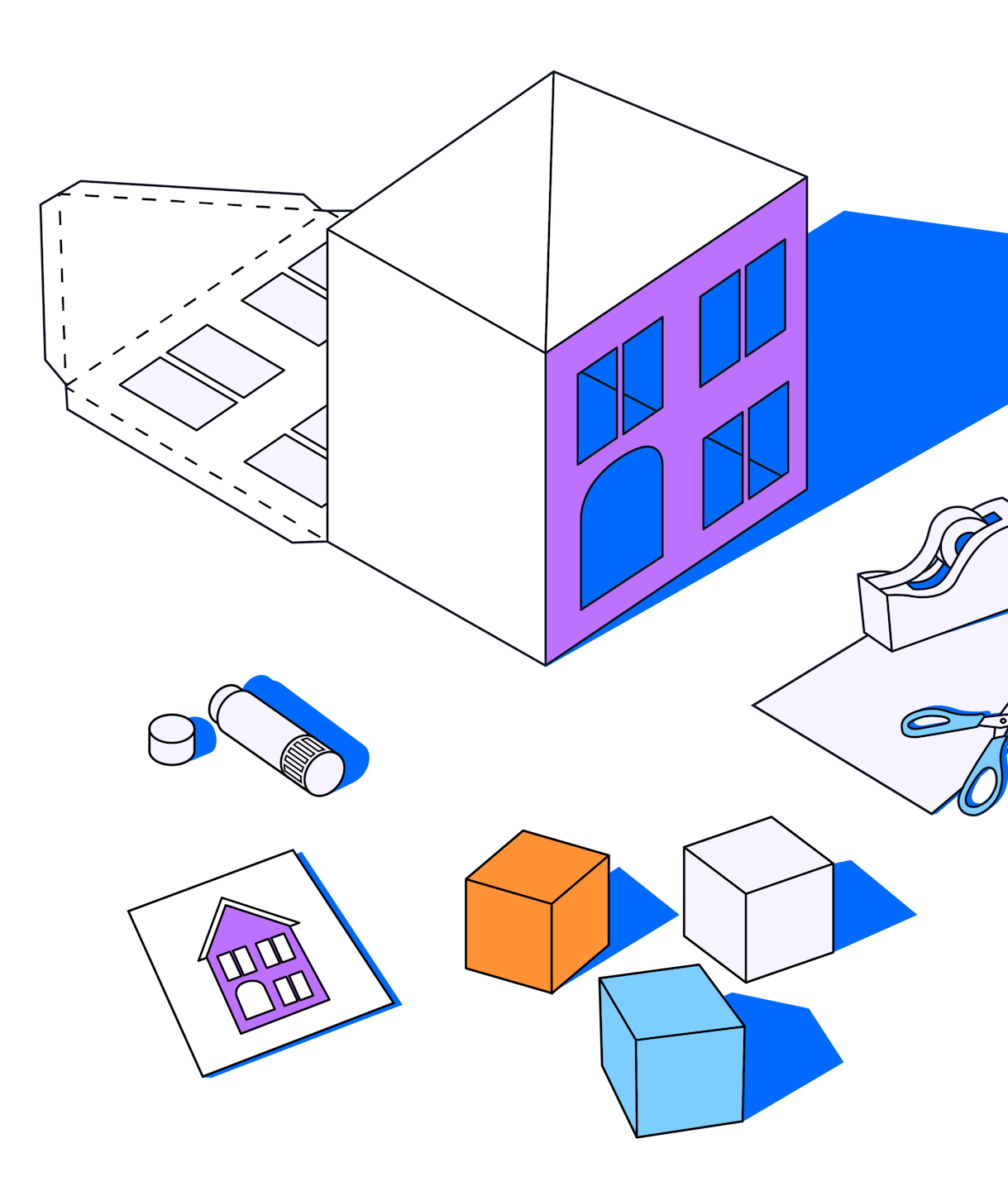When product teams are looking to build a new product or feature, prototyping is one of the least risky ways to explore and validate their ideas with users. This concept is known as rapid prototyping—a design process that helps teams test product ideas quickly.
In this article, we explore what rapid prototyping means and best practices for getting the most out of it. And to get an understanding of the benefits rapid prototyping offers product teams, we sat down with Tulio Domingos, Product Manager at Glovo, to get his view on why prototyping is important.
What is rapid prototyping?
Rapid prototyping is a design workflow that includes prototyping and testing a design solution with users and stakeholders to help designers and product teams refine and validate ideas quickly.
What is rapid prototyping used for?
The main goal of rapid prototyping is to get effective insights and user feedback early, refining the design until it meets all user requirements and needs.
Prototyping is about answering questions.
Tulio Domingos, Product Manager at Glovo
The rapid prototyping process includes three steps: prototyping, testing, and refining. Designers go through these stages in order, improving their solutions based on the prototype testing results and the feedback they received from users. The process occurs iteratively: new ideas are tested and improved upon until the final product is ready for development.
Why is rapid prototyping important?
Rapid prototyping is an essential part of the user interface design process. It allows designers and product managers to test new concepts and theories with users and create a final solution that has been validated before handoff. Instead of waiting until launch to find out if a new product or feature performs well, rapid prototyping enables product teams to get the insights they need earlier in the process.
Let’s now look at three benefits to making rapid prototyping part of your design process.
3 benefits of rapid prototyping
1. Explore new concepts and ideas
Rapid prototyping is one of the most effective ways to quickly explore the concepts and ideas that you and your team come up with. Perhaps someone on the team noticed a trend through research, or maybe you want to refine a feature based on customer feedback. Whatever the idea is, use rapid prototyping to explore possible solutions and quickly understand if that idea is a go or not.
A prototype can completely demolish your opinions, but that doesn’t mean it’s a failure—it served its purpose of providing answers.
Tulio Domingos, Product Manager at Glovo
Rapid prototyping also helps to answer the question of whether a new product is valuable to users. For instance, when the product team at Maze started receiving requests for duplicating projects, we tested whether this solution would offer our customers any value by exploring the concept with our Customer Advisory Board.
If a product is valuable to users and provides a good user experience, they’ll want to use it. Quickly prototyping potential new features and asking your customers for feedback are great ways to explore new concepts without investing too much time into developing a finished product.
2. Minimize development costs on iterations
Another benefit of rapid prototyping is that it allows product teams to minimize the need for iterations in the live product, significantly reducing development-related costs. When a feature or product has been validated with users at the design stage, the risk of building something that doesn't work or isn't valuable is minimal.
As the famous design quote from Dr. Ralf Speth says, "If you think good design is expensive, you should look at the cost of bad design." Research has found that the cost of fixing an issue after release can be four to five times as more than during product design. In that respect, prototyping a solution and testing it with users is a lot less costly than developing a fully-fledged product and blindly releasing it to the world.
3. Launch successfully
A successful product is considered one that is valuable, usable, and feasible. Prototyping can help teams validate these risks at all stages of the development cycle.
Tulio Domingos, Product Manager at Glovo
Last but not least, rapid prototyping is one of the key ingredients of successfully launching a product. There are immense benefits to including users in the product development process, from building an engaged community to identifying proponent customers.
For example, before Freetrade officially launched their mobile app to the App Store, they already had a 20,000 customer waiting list. Their community had been an integral part of the development process since the early stages, and the Freetrade team regularly contacted their users for testing and feedback. The result? A successful launch day with an already existing customer base.
Types of prototypes
Now that we went through the benefits of rapid prototyping, it's time to build a prototype and start testing. Let's look at a few types of prototypes you can create and how to get started.
In digital design, a prototype is a simulation of an interaction between the interface and the user. You can prototype almost everything in a user interface, starting with a simple interaction and up to a complete representation of the product.
Low-fidelity prototypes
The simplest way to start prototyping is to use pen and paper and create what's known as a paper prototype. This type of prototype is usually referred to as a low-fidelity prototype because of its minimal level of interactivity, visuals, and content.
When you want to communicate your ideas to stakeholders, a low-fidelity prototype comes in handy.
Tulio Domingos, Product Manager at Glovo
Low-fidelity prototyping is a quick and easy way to turn high-level design concepts into testable artifacts. The goal is to validate the product's underlying assumptions and core value and check its functionality rather than its aesthetics.
Low-fidelity prototypes are great for ideation and ruling out multiple solutions at the earliest stage of the design process. Testing wireframes can help you identify the most effective layout of a screen, the user flow, or the best way to present information to users.
Tree testing is a great way to validate the ease of finding items in your product structure. Read more.
High-fidelity prototypes
As you move through the design process, start adding more components such as visuals, copy, or interactions to create a medium or high-fidelity prototype. High-fidelity prototypes are highly functional and interactive. They are best for testing during the latest stages of the design process when you want your customers to feel and interact with a prototype that feels as close to the final product as possible.
Designers usually create high-fidelity prototypes to validate the final design and uncover any usability issues before starting development. One of the main benefits of high-fidelity prototypes is that you can test specific design elements and interactions and get more accurate feedback. This type of prototype also gives your stakeholders a clear idea of how the product will look and work before it goes live.
Want to get actionable insights quickly and remotely? Discover more about remote usability testing.
Rapid prototyping use cases
Rapid prototyping is valuable at all stages of the product development process. Let's take a look at some common use cases:
- Validating new product ideas or concepts: Prototypes can be used to test ideas and concepts early on to determine which ones add real value for users. In this way, you can focus your efforts on building a solution that meets users’ needs and expectations before starting development, saving precious time and resources.
- Market validation: Rapid prototyping can be an invaluable tool for market validation. Instead of just imagining your product, users can interact with a prototype and provide better insights into what works and what doesn’t.
- Testing new features with users: If you want to test new features, building a prototype is the best way to go about it. You can see how users interact with your prototype, identify issues and pain points, and understand what works and what requires attention and iteration.
- Assessing product-market fit: Sharing your prototype with your potential users is an excellent way to gather valuable feedback and evaluate your product-market fit. It allows you to see how well your product is meeting the needs of your target audience and identify growth opportunities.
- Getting stakeholder feedback: Prototyping is a way to turn your idea into something tangible you can put in front of your team and stakeholders. Prototypes support communication and encourage stakeholders to provide feedback that can inform future decisions.
Tips for making rapid prototyping part of your process
There are a few best practices to keep in mind to ensure you get the most out of rapid prototyping. In this section, we explore those best practices and how you can implement them into your workflow.
Rapid prototyping is a useful instrument in product discovery as a whole, and it’s not only a tool for product managers but also engineers, designers, researchers—the entire team.
Tulio Domingos, Product Manager at Glovo
- Make it quick: Rapid prototyping has its name for a reason. Don’t try to develop the most interactive prototype and spend a lot of time making it perfect. The goal is to get your ideas out and test them with people as soon as possible.
- Test with real users: Selecting the right participants for your prototype test is critical. The ideal candidates are users who’ve requested a product or feature or participants who meet the criteria of your target personas.
- Establish a test goal: Before you even create a prototype, take a moment to identify what you’re trying to find out by running a test. Whether that’s validating a product idea, testing the usability of a design, or something else, define your end goal from the start.
- Include stakeholders: Rapid prototyping is helpful to different team members across the board—product designers, marketers, product managers, and so on. Results garnered from testing and user interviews can yield useful insights and allow you to get buy-in on product decisions when all stakeholders are involved.
Wrapping up
Rapid prototyping is an effective process for building a great product. The feedback you get from users during the product development stage is one of the most significant prototyping and early testing benefits. So next time you struggle with a product idea or want to validate a design concept, try building a prototype and testing it with users—it's guaranteed to reveal at least a few actionable insights.
Frequently asked questions about rapid prototyping
What is rapid prototyping?
What is rapid prototyping?
Rapid prototyping is an iterative approach to user interface design that can help you test and validate ideas early in the design process. It includes prototyping and testing a design solution with users and stakeholders, and quickly refining and iterating on that solution until final.
What are the types of rapid prototyping?
What are the types of rapid prototyping?
Rapid prototyping methods are usually divided into two categories: low-fidelity and high-fidelity prototyping. Low-fidelity prototypes are basic representations of what your final product might look like and are often used in the early stages of the design process to test concepts and ideas. High-fidelity prototypes are highly functional and interactive. They are mainly used to test usability and identify issues and pain points in the workflow.


